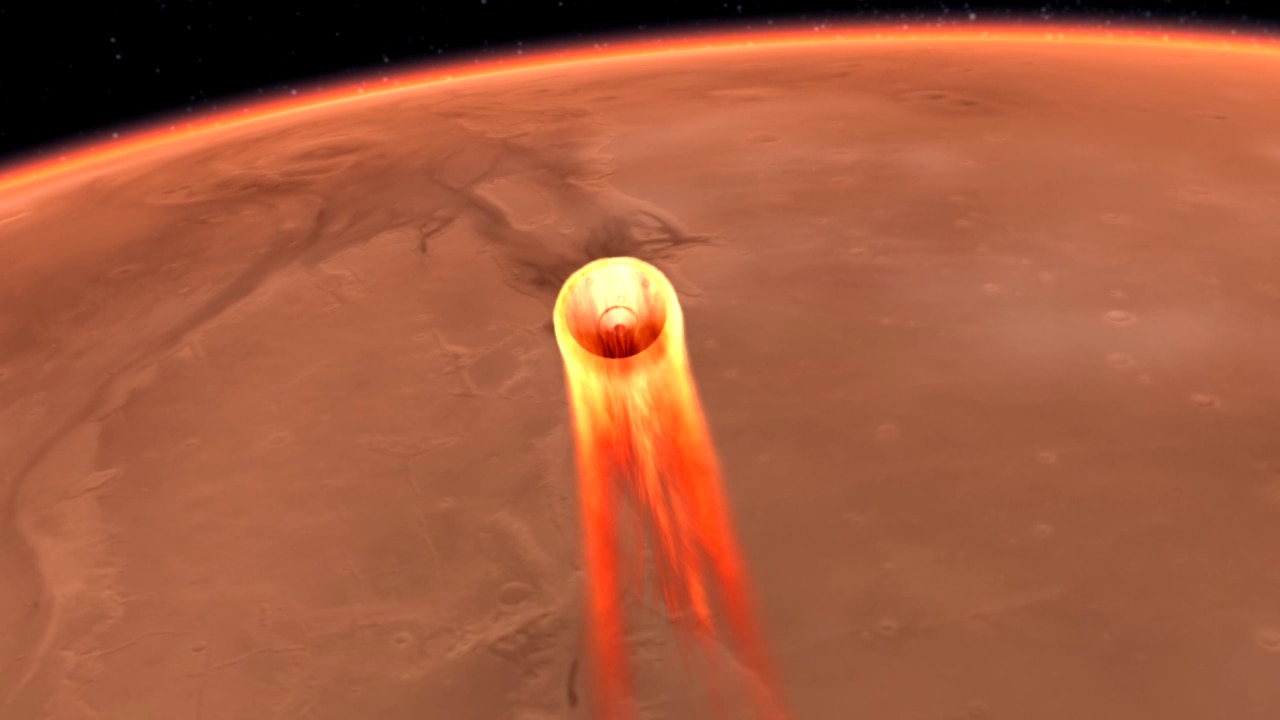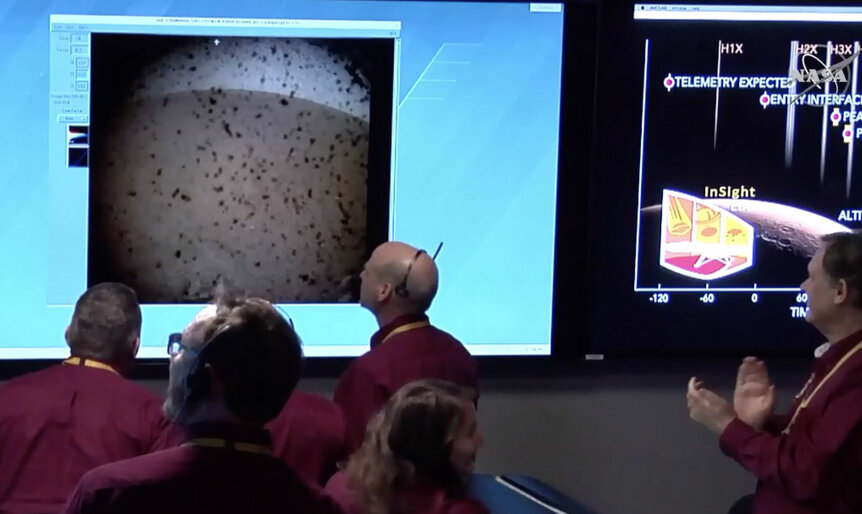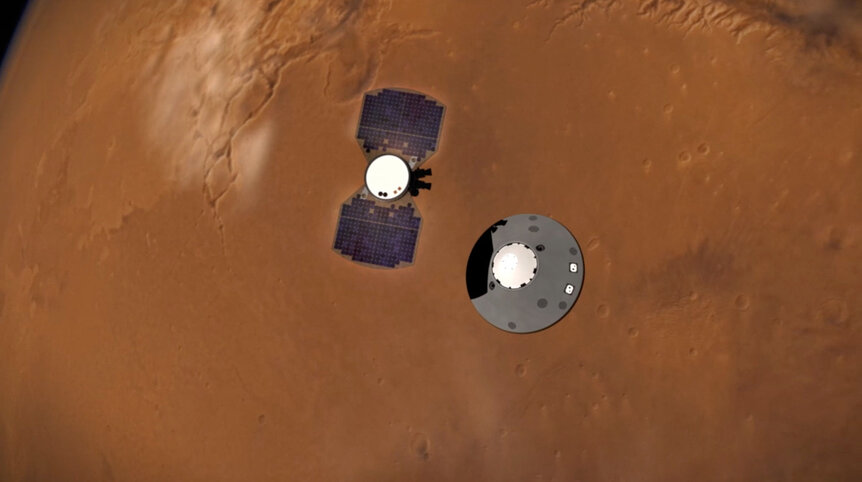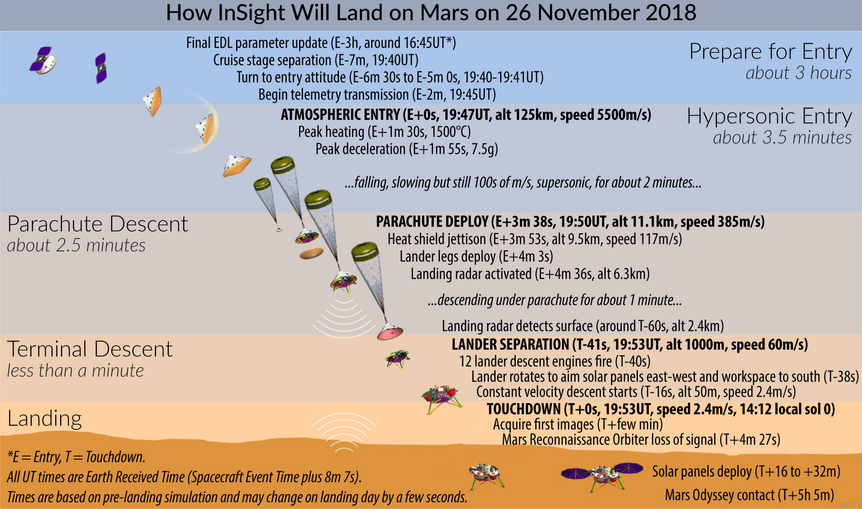Create a free profile to get unlimited access to exclusive videos, sweepstakes, and more!
Mars InSight lands on the Red Planet today! Here's how it'll happen.

UPDATE (Nov. 26, 2018 at 20:10 UTC): Mars InSight is sitting on the surface of Mars!
The atmospheric entry and descent went perfectly, and we now have another robot on Mars. Happily, the CubeSats MarCO-A and B were able to relay InSight's first image from the surface to Earth:
The black dots are dust on the dust cover, but you can see the horizon (curved due to the camers using a fisheye lens) and some small rocks. The whole point of InSight was to land it in the flattest, rock-free area they could find. Looks like they did just that.
C O N G R A T U L A T I O N S to everyone on the InSIght team!
And to all humans. We did good.
Today, Monday November 26, 2018, the Mars InSight probe will land on the red planet.
[Right off the bat, you can watch this happen today LIVE on various streams listed on the NASA Mars InSight site. You can also follow the mission’s Twitter feed.]
It launched on May 5, 2018, and at the time I wrote an overview article that’ll get you up to speed on what InSight will attempt to accomplish. In brief: It’s a lander (not a rover), and is designed to probe the interior of Mars. It’s equipped with seismographs to detect marsquakes, a probe that will dig 5 meters down into the ground to measure how heat flows up from the interior, and radio antennae that will very carefully measure Mars’ rotation to look for wobbles that reveal the interior structure.
Along for the ride are two small CubeSats called MarCO-A and B (nicknamed EVE and Wall-E, because of course). They’re testbeds to see if the tiny (10 x 20 x 30 cm) probes can be used for interplanetary missions; they’ll be used to transfer signals from InSight back to Earth as a backup for the primary communications relay (that is, Mars Reconnaissance Orbiter and Mars Odyssey, already in orbit). In fact, because the CubeSats will fly past Mars and not go into orbit, they’ll have InSIght in their view for longer than the orbiting missions will, so we may hear back from them before the bigger primary relays!
The landing should happen at 19:54 UTC (2:54 eastern US time — that’s the time the signal will get to Earth from Mars after traveling for eight minutes and seven seconds at the speed of light). But to get to the surface, a whole lot has to go right first. As usual, my friend Emily Lakdawalla at The Planetary Society has a fantastic and very detailed explanation of everything. It’s thorough: She has the timings listed in UTC, various other time zones, and in terms relative to touchdown. NASA also has a landing press kit with loads of info.
If you watched the “Seven Minutes of Terror” as Curiosity descended to the surface of Mars, the events for InSight will sound familiar. The descent uses much of the same ideas (though no skycrane this time). Here’s a good video put together by the folks at NASA/JPL describing it:
InSight is attached to a cruise stage, hardware that has provided power and propulsion on the trip from Earth to Mars. Separation should occur at 19:40 UTC. Atmospheric entry begins about 7 minutes later. Peak heating and deceleration occur two minutes after that.
At 19:51 the parachute will deploy. 15 seconds later the heat shield that protected InSight from the heat of atmospheric entry will drop off, and 10 seconds after that the three landing legs pop out. The landing radar activates after that, the parachute and backshell (which attaches the ‘chute to the lander) will drop away. Immediately after that the landing rockets fire, which will slow the lander to about 8 kilometers per hour (a brisk walking pace).
If all goes well, InSight will then touch down. The rockets will turn off, and humanity will have increased the robotic population of Mars by one.
It’s not certain when the first images will be sent back. It could be as early as 20:04, just minutes after touchdown, but it may take up to a day. About five hours later, Mars Odyssey will fly over the landing location and see if the solar panels have deployed.
And then the fun begins! This is a deep geological science mission, looking to find out what’s inside Mars. We’re not even 100% sure if the core is molten (like Earth’s) or not, but InSight should be able to tell — again, not directly, but through Mars’ rotational behavior.
I find it amazing that we know so much about science, so much about things we can’t ever possibly hope to see first hand — like the core of the Earth — that we can then load up a rocket full of gizmos, shoot it to another planet, and then probe it for things we can’t ever possibly hope to see first hand.
And the next chapter in this exploration starts today. Let’s see what happens!






























